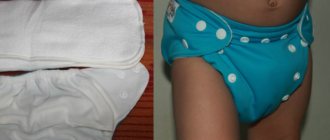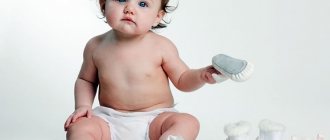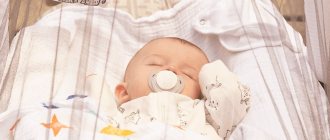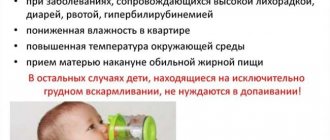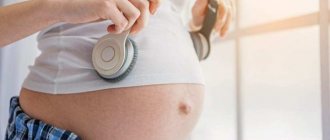Doing without diapers is difficult, but possible. Previously, mothers placed reusable rag diapers under the baby’s bottom, which they sewed themselves. Today, parents prefer to use cellulose-synthetic diapers. But not many of them know that you can potty train a baby at the age of 3-4 months.
How to understand that a child wants to go to the toilet?
A newborn baby often soils his laundry, he pees every half hour and adds to his mother’s worries. Previously, when there were diapers, women were constantly running around with basins and were torn between the child and the laundry. Now everything has changed, and you can devote more time to your baby, forgetting about dirty pants.
Everything seems to be fine, but is it comfortable for a baby in diapers? Does he need them? Adults rarely think about this, pushing the baby’s needs into the background.
A child needs constant care and attention; he cannot do without it. If you monitor your baby carefully, you will notice that in the first few months after birth he gives his mother “signals” that he wants to go to the toilet.
How does a baby behave if he wants to pee or poop:
- grunts;
- sniffles;
- cries;
- expresses concern.
If a child is crying, he may need to go to the toilet.
Previously, women paid special attention to this, now mothers are not so vigilant, but it’s a pity, you can miss the moment.
When the baby turns 3-4 months old, he will do “his own business” without notification, so you need to start putting the baby on the potty as early as possible.
Baby sleeps without diaper
When the child is completely accustomed to walking without a diaper during the day, you can begin to teach him to do without a diaper at night. This should also be done gradually. There's no need to rush here. If the baby is capricious and anxious, it is recommended to wait a little. And try again after 3-4 days.
Before going to bed, it is better to make sure that the child does not drink too much. And before you put him to bed, be sure to sit him on the potty. And during the first days it is better not to turn off the light in the toilet. Leave the night light on in the bedroom overnight. The baby may wake up, ask to go potty, or go on his own. And in the morning, even if he wakes up dry, sit him on the potty. And be sure to praise him and point out to him that today he woke up in a dry bed.
But if the child’s bed is often wet in the morning, then it is better to wait until weaning himself from diapers at night. And don't worry about it, it's okay. You can continue to put him in a diaper until he starts waking up with a dry diaper. And then you can calmly put your baby to bed without a diaper.
There is nothing difficult about weaning babies off of diapers. Weaning should begin only when he is prepared for it psychologically and physiologically. But you shouldn’t listen to the advice of kind and experienced older women and all-knowing grannies. Before you start weaning your baby, you need to explain to him what the potty is for. And tell him what sounds he should make when he wants to go to the toilet.
Is it normal to keep a baby in diapers all the time?
Not many people are ready to do without the benefits of civilization. Therefore, a large number of mothers keep their children in diapers and think that they have found the ideal solution to the problem. It's not quite like that.
What are the risks of constantly using diapers:
- the child stops giving “signals”;
- rashes may appear on the skin;
- It is difficult to potty train a baby.
When a child does not experience discomfort in wet underwear, it is difficult to teach him to “go potty.” The baby will continue to reflexively “relieve himself” and will not ask to go to the toilet.
The potty training procedure will take more time and effort than you would like. The child will pee at home and away, but it is difficult to guess from his behavior what he wants. The reason for all this may be precisely the diapers and the habit that the baby formed earlier.
With constant use of diapers, it is difficult to toilet train a child
Initially, a newborn baby has a need for cleanliness and comfort, so he begins to cry when he pees.
How to wean a child from sleeping in diapers
When a child loses the habit of sleeping without a diaper, parents need to show gentleness and patience, and should start only after the child can easily do without a diaper during the day. If the baby cries and is capricious, then you should not force him. Wait a week or two and try again.
Newborn sleep - how long should a baby sleep? Organization of sleep and what you need to know about baby's sleepMental retardation - symptoms, forms, diagnosis and degrees. Main signs and methods of treatment
- Can a person who is not the owner of the car apply for compulsory motor liability insurance?
Before bedtime, do not let your baby drink and be sure to sit him on the potty. It is better to leave the night light on at night so that, if necessary, the child can go to the potty at night on his own. In the morning, in any case, put him on the potty, regardless of whether the baby peed at night or not.
When the child wakes up dry, he should definitely be praised and paid attention to the dry crib.
If you can’t keep your baby’s bed dry for a long time, then you need to postpone the process and use diapers until they remain dry after the night. The question “how to wean a child off diapers at night” worries many parents, but usually the child himself finds the answer over time.
Weaning a child off a diaper is not difficult, the main thing is to be patient and focus on your baby, without listening to the advice of “experts”.
How to plant a baby?
At home, you can get by with just diapers and refuse diapers. If the apartment is hot, then it is better to put the baby on a covered sofa and watch him for a while. When the child begins to grunt or sniffle, or show dissatisfaction, you need to pick him up and put him to your chest. This will make it easier for the baby to “do his business.”
It is preferable to feed the baby in a sitting position; the mother should spread her legs to the sides and hold the baby so that he is directly between her legs. You need to place a wide basin or container on the floor under the baby.
Some babies cry a lot during bowel movements. This is due to the fact that the process causes them serious discomfort and is accompanied by mild pain. If the mother presses the baby to her chest, she will help him cope with unpleasant sensations more easily.
At first, before going to bed, it is better to put disposable diapers on your child.
It will be difficult to do without diapers and oilcloths; you need to constantly monitor the baby, even wake him up at night and drop him off. Therefore, at first it is better to use “safety net” and place disposable films under the baby.
What are the harms of wearing diapers for a long time?
Despite all the convenience of disposable diapers, there comes a time when the baby has to be weaned off them. This is especially true for those children who enter kindergarten. In some preschool institutions, children are not accepted into the nursery group (from 1.5 years old) if they cannot do without a diaper during the day.
Parents should understand the importance of this process, since stopping the use of diapers is a necessary step in potty training a baby.
Why is it still necessary to wean a child off diapers if he has clearly grown beyond the acceptable age?
- Difficulty with potty training.
A child who is accustomed to peeing and pooping in diapers does not realize the need to do this in some other place. If the baby is constantly in a diaper, the likelihood of teaching him to ask to go to the potty is very low.
- Lag in the development of natural skills.
By about 2 years of age, the child begins to understand his needs and can successfully control them. Attentive mothers notice the signs given by a child who wants to go to the toilet. This could be squeezing the legs, a frozen position (for a few seconds) or the sounds that the child usually makes at this moment. If the baby is able to show with gestures that he wants to pee or go big, he should stop using diapers.
- Violation of hygiene standards.
Urine contains a large number of bacteria and their waste products. An older child (1.5-2 years old) pees a lot, so according to hygiene rules, the diaper should be changed after each bladder emptying. Not all parents comply with these standards, which is fraught with the development of infectious processes.
- Diaper rash and rash.
Lack of air and constant contact with urine can lead to diaper rash and rashes. Most often, such phenomena are observed in children over 3 years of age who use diapers for a long period of time (for example, overnight sleep).
The psychological aspect is no less important. A child over 2.5-3 years old who wears a diaper for a walk may become an object of ridicule from his peers. Children have a hard time with this kind of attitude, so you shouldn’t delay weaning off diapers.
Night without diapers
Where would you be without diapers at night? - that's right, nowhere. The child sleeps well and the bed remains dry. But some mothers manage to give up diapers at night.
If at night the mother notices that the baby has begun to worry, then most likely he wants to go to the toilet. You need to take the baby in your arms and attach it to your chest (all the same as during the day), placing a basin under the baby. Often infants do not even wake up; they suckle at the breast with their eyes closed and successfully defecate.
You definitely need to get your baby to sleep. The baby will probably want to go “little” or “big” before he goes to bed.
If the mother sleeps with the baby, she will be able to more easily detect changes in the baby’s condition. She will react faster and have time to drop the baby off before he pees.
Life without a diaper. Questions and answers
1. I believe that a child under 2 or 3 years of age is not able to control the muscles responsible for excretion. Isn't it violence to toilet train a child before he is old enough?
The answer is simple: “No.” Natural Baby Hygiene is not a toilet training method. The main thing here is not to drop off the child on time. Because children are not taught to ignore natural sensations and needs, they do not have to be retrained to recognize them again. There will be no need to later teach your baby NOT to use his clothes as a toilet.
In the Natural Hygiene Method, the main thing is to understand the needs of the baby and rush to help in time. The child shows his need, and then relaxes in the hands of an adult and pees/poops voluntarily. There is no violence here, if it is possible here at all.
Contrary to traditional beliefs, babies are able to recognize their pee/poop needs from birth and can control these muscles from birth. The myth that a child must be “trained” to control them has arisen due to a global misunderstanding of the abilities of children.
2. At what age is it better to start?
Ideally - in the first days or weeks after birth. In countries with a “non-modern” culture, mothers begin to plant their babies in the period from birth to three months, in different ways in different cultures. I advise “modern” parents to start as early as possible. It's best to start before the baby is 5 or 6 months old , because then the baby will lose control of his discharge due to diapers or nappies.
You can start successfully with older children, but it will require more time, effort and attention. This requires a more subtle approach.
3. How can I feel my baby's rhythms if I use diapers at first?
Obviously, it is easiest to monitor your baby when he is not in diapers. There is no doubt that this is also better for the child. Some parents prefer not to use them at all and practice constant skin-to-skin contact.
However, many mothers use diapers from time to time, especially in the beginning when they are just getting used to their baby's rhythms. This makes it easier for parents who are afraid of missing out on unexpected “surprises.”
If your baby has just been born, is still very small and not particularly nimble, in this case it is ideal to put the baby on a diaper (rather than putting a diaper on the baby).
A newborn can be carried in your arms, holding an unfastened diaper or diaper under the bottom. You can put a diaper in a sling. In fact, flannel diapers or pieces of old towels are better for this purpose than the most modern diapers.
Just don’t forget to remove the diaper or nappy when the child wants to do “his business”! Don’t forget about the hinting sound (like “ps-ps”). When you find that you're using up one diaper or diaper for the entire day, you may be able to stop using them.
4. What signals does a child give when he wants to go to the toilet?
For a very small newborn, the “signals” are:
- writhing, arching of the body,
- grimaces on the face,
- the look of “internal consignal” is like this: he will approach (crawl) up to the mother, lead her with him to the “toilet” place, will squirm in his arms, try to get out of the sling or “kangaroo”, get off the bed. He will persistently attract attention to himself, make a “hinting sound,” hold on to the genital area, or sit in your arms in a position familiar to the toilet. If the baby is naked, you will be able to see the corresponding muscles moving 'down there'.
For some children the signals are more obvious, for others they are less noticeable. The signals also change as the child grows. However, careful observation of your baby will tell you how to recognize the right moment.5. When I try to recognize my baby's signals, I don't understand anything. What should I do?
Keep trying. Be gentle and attentive to your baby. Recognizing signals can be difficult, especially because in our culture we are not used to it. Many mothers succeed in this from the very first day, but for many, complete understanding with the child comes after a few days or even weeks. Patience, time and constant practice will help you.
Many mothers give up and stop breastfeeding in the first days or weeks due to unusual difficulties. But those who continue soon have a very positive experience. The same goes for the Natural Hygiene method. Like breastfeeding, this method is natural and instinctively familiar, although it requires patience and persistence at first.
Remember that there are different approaches. If signals and intuition do not help you, try to feel the child’s internal rhythm. Remember how your baby behaves when he “walks” and at what time this happens. For example, children often “walk” immediately after waking up or some time after feeding (for example, after 10-15 minutes). Help your baby “get things done” by feeding him at the right time. Make a “hinting sound” and wait.
When the mutual understanding between mother and baby becomes stronger, the child will begin to give signals more persistently. Remember to make a “hinting sound” even if you are late. Then your baby will learn to associate this sound with the possibility of peeing or pooping. Some children even begin to publish it themselves when they “ask for it.”
6. What to do if the child “walks” precisely when he is suckling on the mother’s breast?
This is the easiest time to apply the Natural Hygiene method because you know exactly when it will happen. Place the baby's bottom in a potty or small basin. You can wrap the baby in a towel. And don’t forget about the “hinting sound” so that the baby learns to associate it with his “deeds.”
7. Doesn’t a newborn “walk” the very second he wants? Is it really possible to get to where you need to go with it?
Even the youngest children (and especially those with whom the Natural Hygiene method has already been used) usually signal their needs in advance, even before they can no longer stand it. Of course, the younger the child, the shorter the time between when he realizes the “need” and the very moment of release. Conscious and intense parental attention will help you here.
Note that the Natural Hygiene method is not about “how to plant” or “when to run.” The main thing is that the mother tunes in with the baby on the same wavelength, feels the “signals” of her child deep in her heart. Then the mother will be able to recognize the baby’s need to “go” in time and offer appropriate help. There is no need to wait until the little one can no longer endure it.
8. What should I do if my child and I leave the house (for example, to the store)? What should I do if I can’t focus on my baby’s signals in a public place?
The most interesting thing is that some mothers admit that they are much better able to focus on the baby's signals precisely when they are NOT at home. At these moments, the desire to avoid embarrassment intensifies and you listen to the child with all your might. Your attention to your baby increases dramatically!
If you need to “go” away from home, look for a place where the child could do his business. (Translator's note: For Canadian readers, Ms. Bauer recommends public restrooms in this paragraph. Hehe!) Plan your route in advance with these stops in mind. Or stay away from home in the first weeks or even months until you have developed a close and trusting relationship with your baby that brings comfort to both of you.
Many parents put diapers on their little ones when they go out. In this case, think about where you can comfortably change your baby's clothes. Plan and include in your route places where your baby can change clothes or even “do some errands.”
9. What to do at night or during the baby's nap?
There are several options.
Babies rarely pee or poop while in deep sleep. As a rule, they toss and turn first - enough to wake up their mother (if the mother sleeps next to the baby). Mom can take the baby to the right place or simply drop her off over a basin standing near the bed. The basin should be prepared in advance. Babies who don't sleep, toss and turn and make noise at night may simply want to go to the toilet!
Some mothers place their babies before or after nighttime breastfeeding. You can also feed your baby at night by holding his bottom in a basin or potty. To do this, the pot should always be at hand.
You can put a well-absorbing diaper or a towel with oilcloth under the child in case the baby does go to bed.
And, of course, you can use diapers. Although many mothers who use the Natural Hygiene method note that children remain dry for quite a long time or even all night from a very early age. (Translator's note: It is.)
10. Can other adult family members who do not spend much time with the child understand the child’s signals?
Yes, sure! Here, success will depend on the specific situation: on the closeness of the relationship between the adult and the child, on the attentiveness of the adult and, partly, on the desire of the child. Many fathers feel great about their baby and drop off their children in a timely manner. But we must admit that the mother will do the best job at first.
In some countries, various family members, including grandparents and other distant relatives, carry the baby to pee.
Translation by Elena Plastinina
Walking without diapers
You can walk with a child in a stroller without diapers. Especially if it is a warm season outside and there is no risk of the baby catching a cold. The first walk does not last long, and therefore you can go out without diapers. It is enough to drop your baby off before going outside, and then go to breathe fresh air.
Some mothers put a film in the stroller so that it does not get wet if the child pees. Reusable films absorb moisture well; their use will help protect the vehicle from excess moisture.

